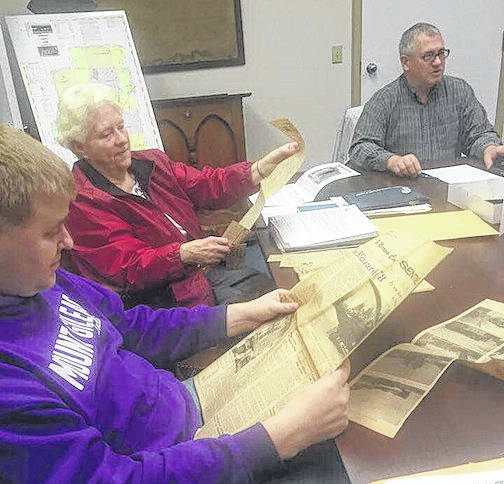MOUNT GILEAD — It’s been 40 years, but memories of The Great Blizzard of 1978 are still vivid for Mike McKinney.
“I hope we never see anything like it again,” McKinney said during a roundtable discussion Thursday night at the Morrow County History Center.
The blizzard, also known as the White Hurricane, was a historic winter storm that struck the Ohio Valley and Great Lakes regions from Wednesday, Jan. 25 through Friday, Jan. 27.
In Ohio, 51 people died as a result of what became known as the storm of the century.
“We were out helping people because I had a four-wheel drive truck,” McKinney recalled.
Fuel oil and groceries were taken to those in the country stranded for days by the brutal blast Mother Nature had delivered.
One blizzard wind gust at Cleveland Hopkins Airport was recorded at 82 miles an hour. The temperature dipped to near zero and wind chills were recorded at -50 degrees. Some snow drifts approached 25 feet high, according to news accounts.
Phylis Miller recounted her diary entries from 1977, a year before this blizzard.
“The high on Jan. 16 was six below, and the low with wind chill was 50 below,” she said.
“We sat around and played cards and watched TV, mostly Gov. (Jim) Rhodes was on. But the epic show “Roots” was also on at that time and we watched that.”
The National Weather Service terms the ’78 blizzard “a storm of unprecedented magnitude.”
“What occurred on Jan. 26th, 1978 in Ohio was not a blizzard. What did occur was even rarer and even more dangerous: a severe blizzard … the worst of winter storms.”
The NWS defines a “severe blizzard” as a storm with winds of 45 miles per hour or greater; a great density of falling or blowing snow; and temperatures of 10 degrees or less.
There was one local fatality, according to Stan Sipe. “A woman in North Bloomfield Township died,” he said.
McKinney was on the road for several days virtually around the clock.
After taking his mother to the phone company to work, McKinney and others began helping stranded motorists along the county’s roadways.
He accompanied a deputy to the home of a woman who was pregnant, told she was about to give birth.
“Her husband was working in Columbus, I believe. We took her to Fulton to a family member’s home, but it was a false labor,” McKinney said.
“We went from one place to another, getting people out of their vehicles and taking them to shelters at churches and schools. We put two and a half tanks of gas in that truck every 24 hours.”
Interstate 71 that cuts through Morrow County was closed. The National Guard sent units in to rescue residents.
McKinney and another man used makeshift tow trucks to pull several semis loose that had frozen to the ground at a truck stop at I-71 and State Route 95. It took them about four hours.
There wasn’t panic — but there was genuine concern — across the county.
“People were running out of fuel oil,” Ellen McMurray said. Others needed baby formula and dry goods.
Volunteer citizens took fuel and supplies via snowmobile through pastures to those who were shut in from Climax to Chesterville.
In Mount Gilead one man said he walked three blocks to Geyer’s to get milk and food. “I never saw a single car on that three-block walk there and back. Not one,” he said.
He said he didn’t lose power at his house, but “the wind blew and blew and blew.”
Sipe said there were only 354 outages reported among the 5,000 electric customers in the village.
Julie Blankenship was a student at Muskingum College in southeast Ohio that winter.
“We were on campus and it was shut down at least a week. You couldn’t get from the the dorms to the quad, where the academic buildings were,” she said.
“We were lucky … the dorm was connected to the dining hall so food wasn’t an issue,” Blankenship said.
Dick Miller brought a commemorative glass tumbler to the discussion.
Inscribed in red are the words “I Survived The Blizzard of ‘78” and “Thirty-four inches of snow. Minus 17 degrees at one point. Barometric pressure 28.47 and winds 70 to 103 miles per hour.”
“There was a lot of the community coming together; people helping one another,” he said.
McKinney said he noticed something new on the roads the next year.
“After that storm, there were a lot more trucks and four-wheel drive vehicles around.”







